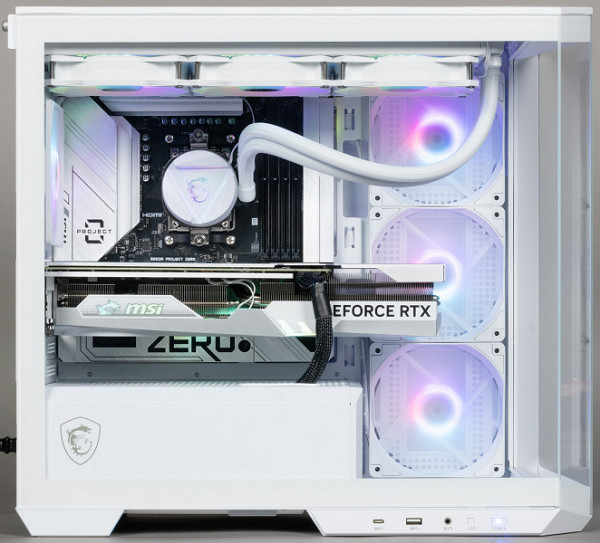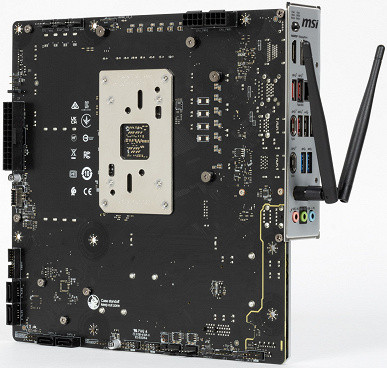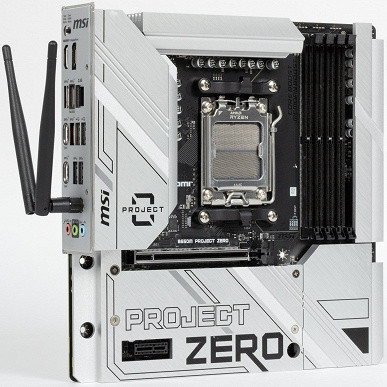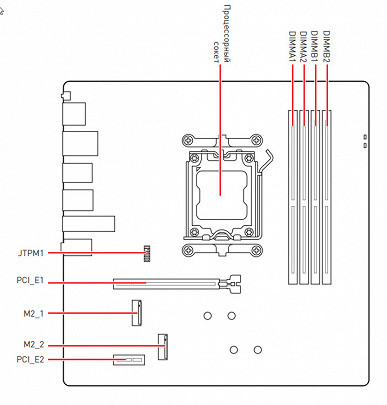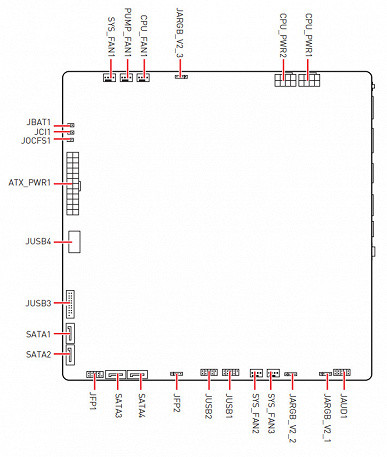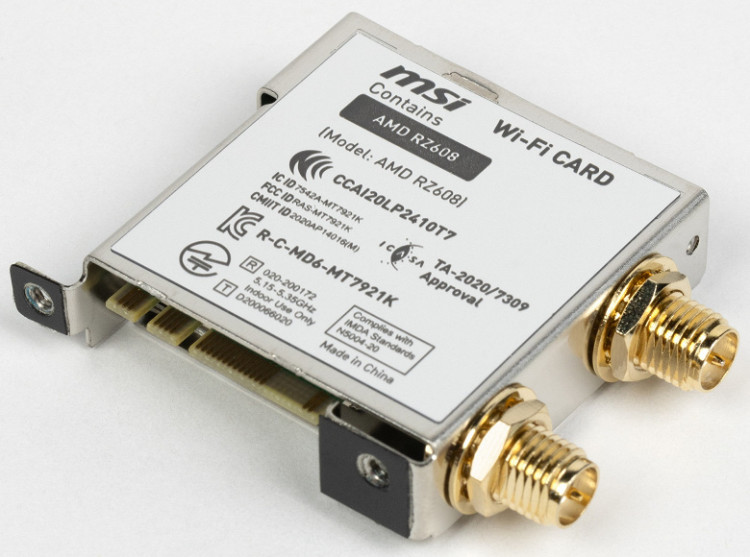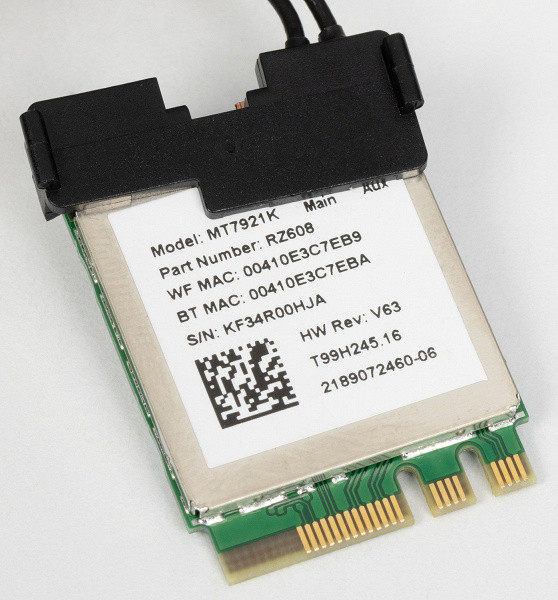As usual, we continue to study motherboards, analyzing their architecture, power supply capabilities, as well as peripheral interfaces and software tools available to the user.
However, this material has its own peculiarity. Together with the motherboard, we will also consider its integration into cases of an unusual design. The fact is that this product is non-standard: most of the connectors are located on the back of the board. Why this is implemented this way — we will discuss at the end of the review. Now we will focus on the board itself, which is built on the AMD B650 chipset of the mid-price segment.
Let me remind you that the B650 and B650E chipsets, as well as the X670 and X670E, differ, in particular, in PCIe support: models without «E» support PCIe 4.0 for the PCIe x16 slot, and versions with «E» — PCIe 5.0.
Below is a table of the key differences between the B650 and X670 chipsets.
| Peculiarities | B650/ B650E | X670/ X670E |
|---|---|---|
| Compatibility with AMD processors | Ryzen 7xxx/8xxx/9xxx | Ryzen 7xxx/8xxx/9xxx |
| PCIe Version (CPU) | 4.0 & 5.0/ 5.0 | 4.0 & 5.0/ 5.0 |
| Number of PCIe lanes (processor) | 28 | 28 |
| Number of PCIe lanes from the processor to the chipset | x4 PCIe 4.0 | x4 PCIe 4.0 |
| PCIe version (chipset) | 3.0 & 4.0 | 3.0 & 4.0 |
| Number of PCIe lanes (chipset) | 12 (8 x 4.0 & 4 x 3.0) | 20 (12 x 4.0 & 8 x 3.0) |
| RAM generation | DDR5 | DDR5 |
| Number of RAM channels | 2 | 2 |
| Maximum number of RAM slots | 4 | 4 |
| Maximum RAM | 192 GB | 192 GB |
| Number of SATA 6.0 Gb/s ports up to | 4 | 8 |
| USB 3.2 Gen 2x2 ports (20Gbps) up to | 1 | 2 |
| USB 3.2 Gen 2x1 (10Gbps) / Gen 1x1 (5Gbps) ports up to | 6 | 8 |
| USB 2.0 ports up to | 6 | 12 |
| Possibility of overclocking by bus frequency | Yes | Yes |
Many users know that MSI has three main lines of gaming motherboards: MEG (flagship series), MPG (a slightly simplified version of MEG, with minimal overclocking functions and additional «features») and MAG (the most affordable gaming segment, without frills).
However, for the first time, our lab received a board that clearly does not belong to budget solutions, but at the same time does not belong to any of these series. Its name is MSI B650M Project Zero, and it is built on the AMD B650 chipset. What does this name mean and what are the features of this model, we will analyze below.
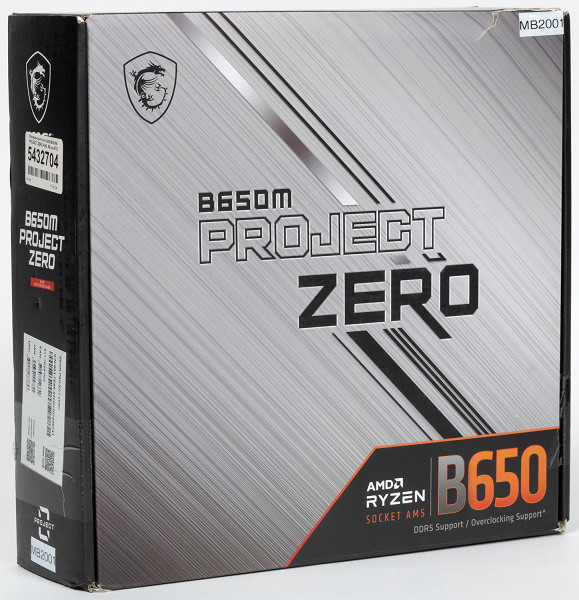
The MSI B650M Project Zero comes in a standard box made of durable cardboard, but with a unique design on the front side, which emphasizes the special status of the board — it does not belong to the usual lines (perhaps in the future this will change, but for now — no). The package contents are located under the board in a separate compartment.
The package contents itself are quite modest: in addition to the usual elements, such as a user manual and SATA cables, the box also contains antennas for the built-in Wi-Fi/BT module, bonus stickers and, in general, that's all.
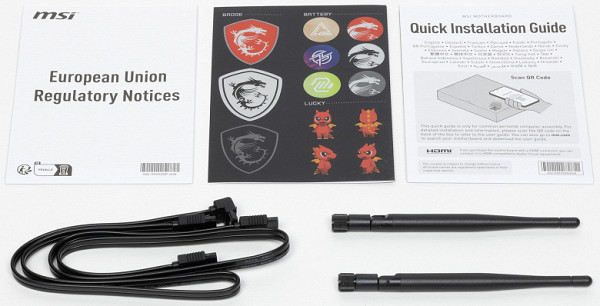
The software is not included in the kit, which is not surprising, since it is usually outdated by the time the board is delivered to the buyer. Therefore, it is better to immediately update it from the manufacturer's website after purchase.
The rear panel plug with connectors is already integrated into the board itself, which simplifies installation.
Form factor
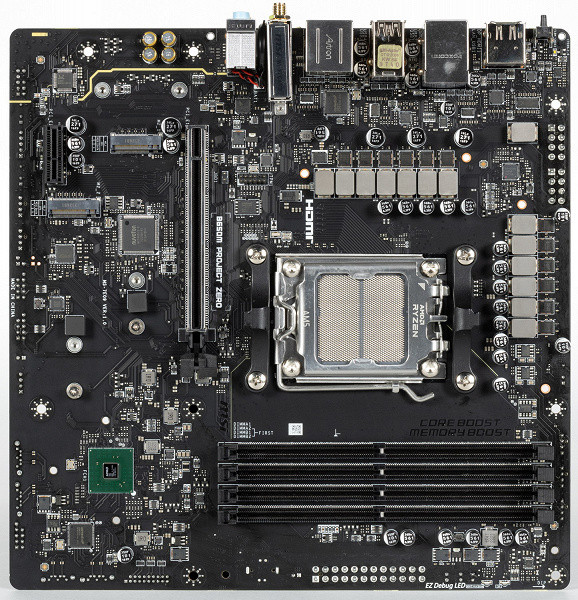
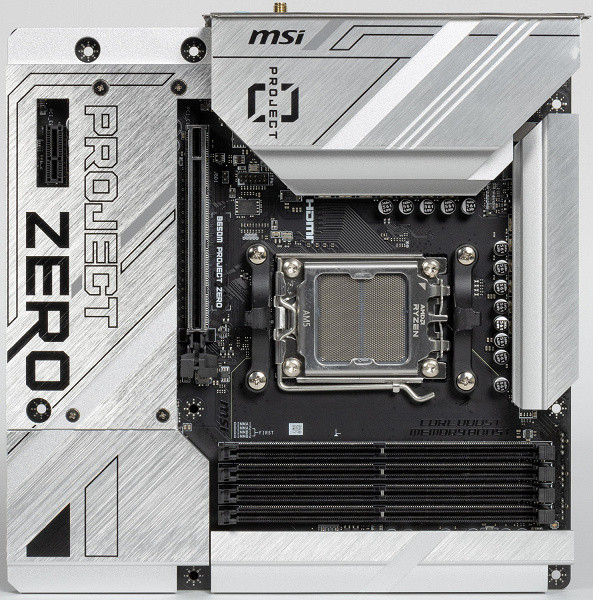
The Mini-ITX form factor is characterized by dimensions of 170 x 170 mm, microATX — up to 244 x 244 mm, ATX — up to 305 x 244 mm, and E-ATX — up to 305 x 330 mm. The MSI B650M Project Zero motherboard has dimensions of 244 x 244 mm, which corresponds to the microATX form factor, and is equipped with 8 mounting holes for installation in a case.
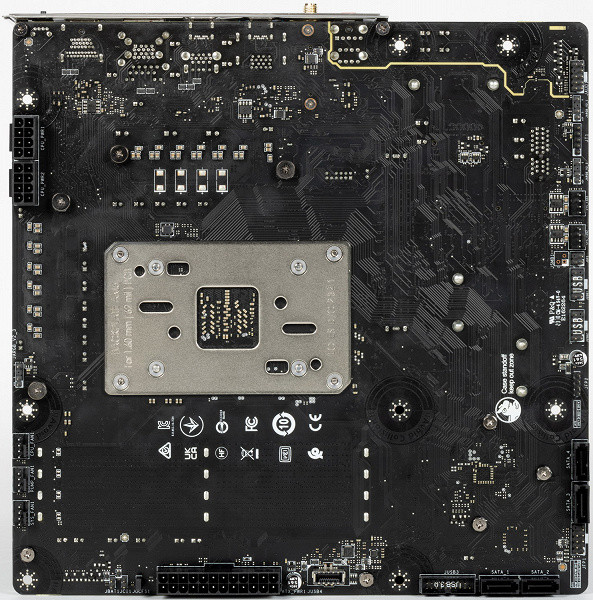
The main feature of this product is the placement of almost all connectors on the back side. There is also a certain amount of element base.
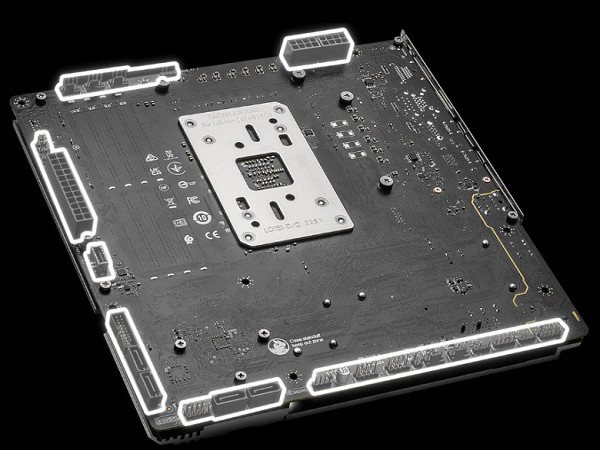
The textolite is made qualitatively: all soldering points are carefully processed, sharp ends are cut and carefully polished. There is also marking of zones where there are no mounting holes, but in these places of the case racks can be installed.
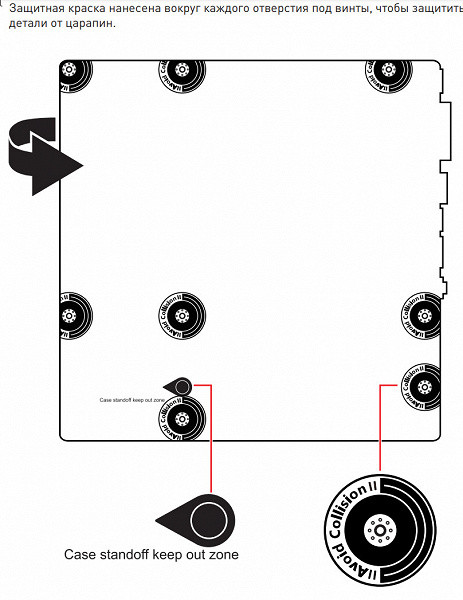
Technical specifications
Traditional table with a list of functional features.
| Supported Processors | AMD Ryzen 7xxx/8xxx/9xxx под AM5 |
|---|---|
| Processor socket | AM5 |
| Chipset | AMD B650 |
| Memory | 4 × DDR5, up to 192 GB, up to DDR5-7600 (XMP/Expo), dual channel |
| Audio subsystem | 1 × Realtek ALC897 (7.1) |
| Network controllers | 1 × Realtek RTL8125BG Ethernet 2.5 Гбит/с 1 × AMD (MediaTek) Dual Band Wireless RZ608 (MT7921) (Wi-Fi 6E 802.11a/b/g/n/ac/ax (2,4/6 ГГц) + Bluetooth 5.3) |
| Expansion slots | 1 × PCI Express 4.0 x16 (CPU) 1 × PCI Express 4.0 x1 (B650) |
| Storage connectors | 4×SATA 6Gb/s (B650) 1×M.2 (CPU, PCIe 4.0 x4 for 2260/2280 devices) 1×M.2 (CPU, PCIe 4.0 x4 for 2260/2280 devices) |
| USB port | 2×USB 2.0: 2 Type-A ports (Black)(B650) 4×USB 2.0: 2 x 4-port internal headers (GL850G) 2×USB 3.2 Gen1: 2 x Type-A ports (Blue)(ASM1074) 2×USB 3.2 Gen1: 1 x 2-port internal header (ASM1074) 1×USB 3.2 Gen2x2: 1 x Type-C port (B650) 1×USB 3.2 Gen2: 1 x Type-C port (CPU) 1×USB 3.2 Gen2: 1 x Type-C internal header (B650) 3×USB 3.2 Gen2: 3 x Type-A ports (Red) (B650+CPU) |
| Rear panel connectors | 1 × USB 3.2 Gen2x2 (Type-C) 1 × USB 3.2 Gen2 (Type-C) 3 × USB 3.2 Gen2 (Type-A) 2 × USB 2.0 (Type-A) 2 × USB 3.2 Gen1 (Type-A) 1 × RJ-45 3 x mini-jack audio 1 × HDMI-out 1 × DP-out CMOS reset button 2 x antenna connectors BIOS flash button |
| Other internal elements | 24-pin ATX power connector 2 x 8-pin EPS12V power connectors 1 x M.2 (E-key) slot, occupied by a wireless network adapter 1 x USB 3.2 Gen2 Type-C port connector 1 x USB 3.2 Gen1 port connector 2 x 4 USB 2.0 ports connectors 5 x 4-pin fan and water pump connectors 3 x addressable ARGB strip connectors 1 x front panel audio connector 1 x CMOS reset connector 1 x TPM security connector 1 x secure boot connector 1 x front panel control connector |
| Form factor | microATX (244×244 mm) |
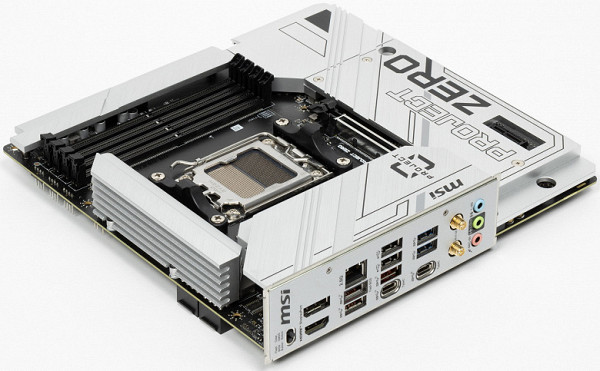
Main functionality: chipset, processor, memory
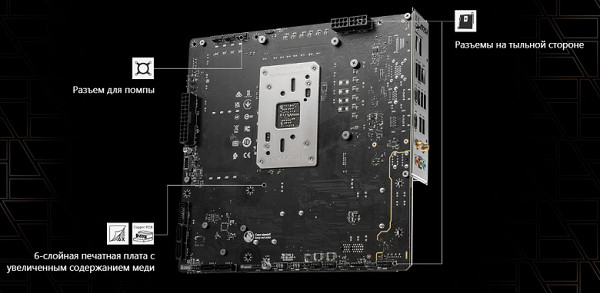
Scheme of operation of the chipset+processor bundle.
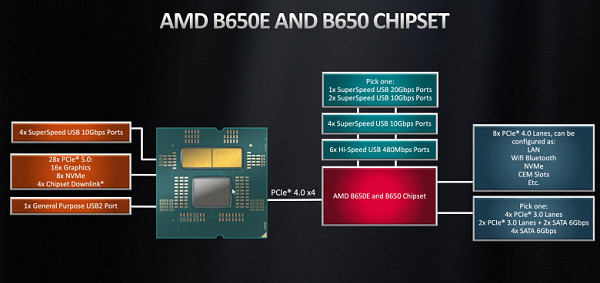
All Ryzen 7000, 8000, and 9000 series processors support:
- 3 USB 3.2 Gen2 Type-C ports,
- 1 USB 3.2 Gen2 Type-A port,
- 1 USB 2.0 port.
Only Ryzen 7000 and 9000 support:
- 28 I/O lanes (including PCIe 5.0, but downgraded to 4.0 with the A620 chipset):
- 4 lanes (downgraded to 3.0 with the A620 chipset) are used to communicate with the chipset,
- 16 lanes are for the PCIe 4.0 graphics card slot,
- The remaining 8 PCIe 4.0 lanes:
- 4 lanes are for the M.2 slot,
- The remaining 4 lanes can be configured by the motherboard at the discretion of the manufacturer.
Only Ryzen 8700/8600 support:
- 20 I/O lines (PCIe 4.0):
- 4 lines (with the A620 chipset downgraded to version 3.0) are used to interact with the chipset,
- 8 lines are for the PCIe 4.0 video card slot,
- The remaining 8 lines:
- 4 lines are for the M.2 slot,
- the remaining 4 can be configured at the manufacturer's discretion.
Only Ryzen 8500/8300 support:
- 14 I/O lanes (PCIe 4.0):
- 4 lanes (with the A620 chipset downgraded to version 3.0) are used to interact with the chipset,
- 4 lanes are for the PCIe 4.0 video card slot,
- The remaining 6 lanes:
- 4 lanes are for the M.2 slot,
- The remaining 2 are at the manufacturer's discretion.
The B650/B650E chipset supports:
- Up to 6 USB 3.2 Gen2 ports,
- 1 USB 3.2 Gen2x2 port,
- 6 USB 2.0 ports,
- 12 I/O lanes:
- 8 PCIe 4.0 lanes,
- 4 PCIe 3.0 lanes (include up to 4 SATA ports).
In total, with the Ryzen 7000/9000 processor and the B650/B650E chipset, you can get:
- 16 PCIe 5.0 lanes for video cards (from the processor),
- 1 USB 3.2 Gen2x2 port (from the chipset),
- 10 USB 3.2 Gen2 ports (4 from the processor, 6 from the chipset),
- 7 USB 2.0 ports (1 from the processor, 6 from the chipset),
- 4 SATA 6 Gbps ports (from the chipset),
- 8 PCIe 5.0 lanes (from the processor), of which 4 go to the M.2 slot, and the remaining 4 can be used for other ports and slots,
- 8 PCIe 4.0 lanes (from the chipset),
- 4 PCIe 3.0 lanes (from the chipset).
The result: up to 18 USB ports and up to 20 free PCIe lanes (including up to 4 SATA ports).
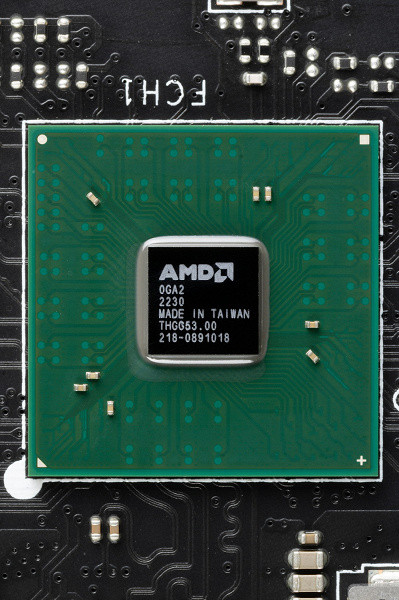
Let me remind you that the AMD B650 and B650E chipsets are identical in functionality, including the number of ports and lines. The main difference is the PCIe x16 slot for video cards: in the case of the B650E, it works on PCIe 5.0, while with the B650 it works on PCIe 4.0.
Ryzen 7xxx, 8xxx and 9xxx series processors support both DDR5 memory modules with Intel XMP (Extreme Memory Profile), which are adapted to XMP settings via Direct Over Clock Profile (DOCP), and modules with their own AMD Expo profile.
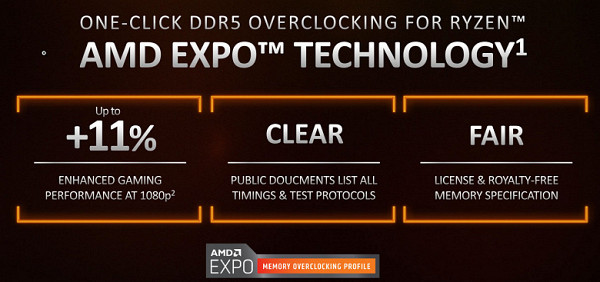
MSI B650M Project Zero supports AMD 7000/8000/9000 generation processors designed for the AM5 socket.
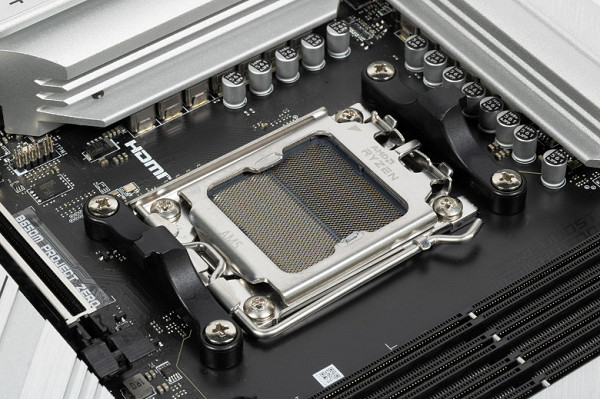
The motherboard has four DIMM slots for installing memory modules. To ensure operation in Dual Channel mode when using two modules, they must be installed in slots A2 and B2. The board supports unbuffered DDR5 memory with a maximum capacity of up to 192 GB and is compatible with XMP and Expo overclocking profiles.
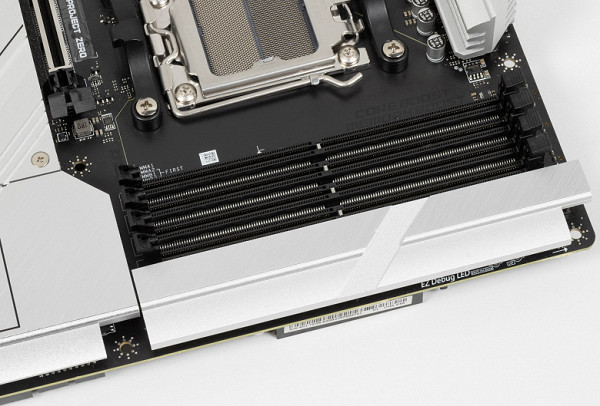
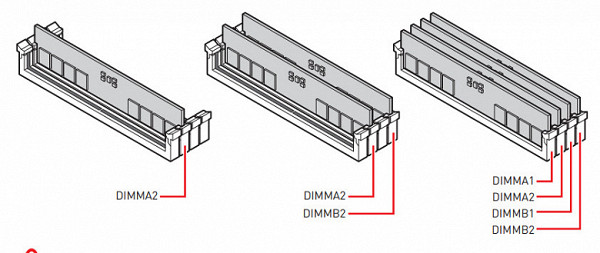
The DIMM slots on the board do not have a metal frame, which usually prevents deformation of the slots and the printed circuit board when installing memory, and also reduces the level of electromagnetic interference. However, in the area of the locks, where the memory modules have a cutout, there are metal inserts that provide more reliable fixation of the DIMM modules.
Peripheral functionality: PCIe, SATA, additional devices
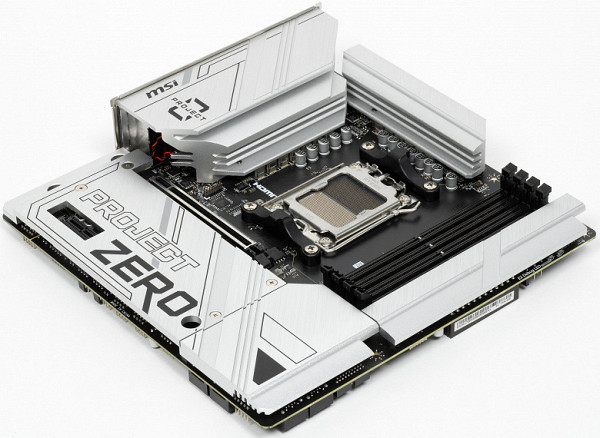
Previously, we looked at the possibilities of combining the B650 chipset and Ryzen processors, now let's find out how these capabilities are implemented in the motherboard in question.
The B650 chipset provides 12 PCIe lanes. Let's calculate how many of them are used to connect various components:
- PCIe x1 slot — 1 PCIe 4.0 lane;
- SATA ports 0, 1, 2, 3 — 4 PCIe 3.0 lanes;
- Realtek RTL8125BG Ethernet controller (2.5 Gb/s) — 1 PCIe 4.0 lane;
- AMD RX608 module for Wi-Fi/BT — 1 PCIe 4.0 lane.
As a result, 7 PCIe lanes (3 from version 4.0 and 4 from version 3.0) are used, including 4 lanes for the SATA ports from the B650.
Now let's see how the PCIe lanes are distributed among the processors in this configuration. All Ryzen 7xxx/8xxx/9xxx models have 24 PCIe lanes (plus 4 lanes for connecting to the chipset). The distribution looks like this:
- M.2 port (M2_1) — 4 PCIe 4.0 lanes;
- M.2 port (M2_2) — 4 PCIe 4.0 lanes;
- PCIe x16 slot (PCI_E1) — 16 PCIe 4.0 lanes.
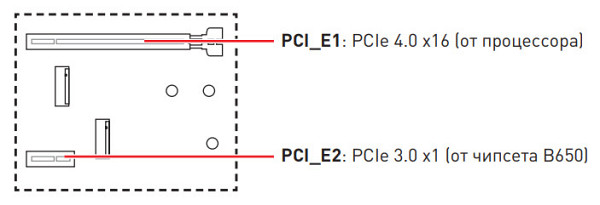
Ryzen processors are equipped with a High Definition Audio (HDA) controller, which allows emulating communication with legacy audio codecs via the PCI bus. The wireless network controller uses the USB 2.0 line from the processor, while the Genesys Logic GL850G USB 2.0 controller also connects to the USB 2.0 line from the CPU (more details below in the section on USB ports).
The motherboard has two PCIe slots: one «long» PCIe x16 (PCI_E1), which receives data from the processor, and one PCIe x1 (PCI_E2) slot, which connects to the B650.
The PCIe x16 (PCI_E1) slot, designed for video cards, has metal reinforcement made of stainless steel, which increases its reliability. This is especially important when frequently replacing video cards, as well as in the case of installing heavy top-end graphics adapters, since such protection copes better with the bending load. In addition, this reinforcement protects the slots from electromagnetic interference.
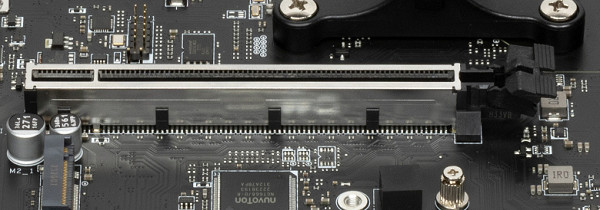
This slot also differs in that it has a wider latch at the end for more convenient removal of expansion cards from it.
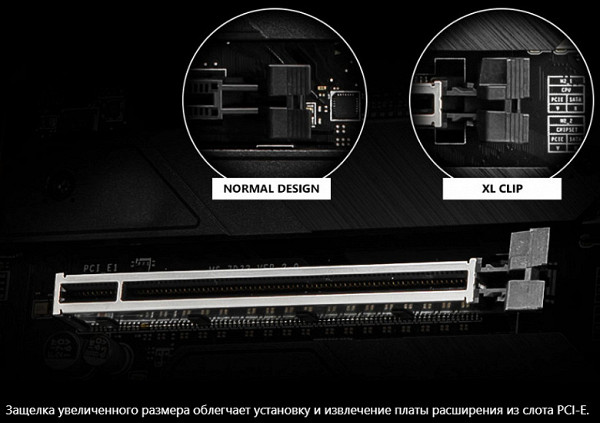
The motherboard supports installation of cooling systems of any size.
Since the operation of PCIe slots and M.2 ports is not subject to switching, there are no multiplexers, as well as amplifiers (re-drivers) of the PCIe signal.
Now let's move on to the drives.
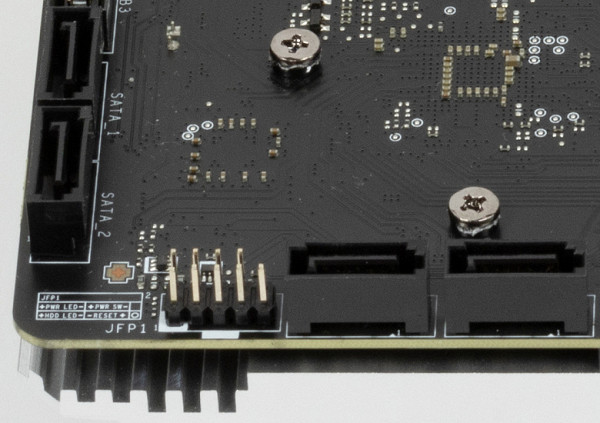
The motherboard is equipped with 4 Serial ATA 6 Gbps connectors and 2 slots for M.2 drives. Four SATA ports, implemented via the B650 chipset, support RAID creation and are located in a vertical orientation on the back of the board.
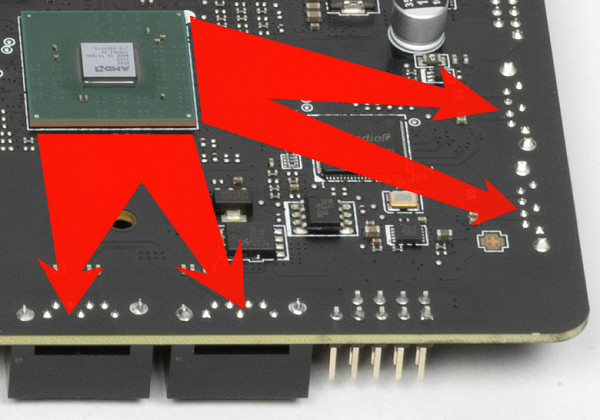
The motherboard has 2 M.2 form factor sockets.
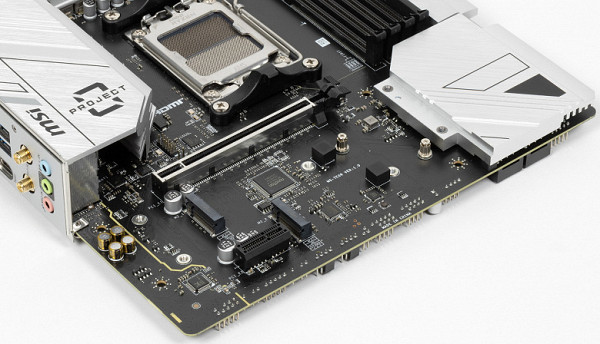
Both slots support 2260/2280 module sizes and only work with PCIe interface modules.
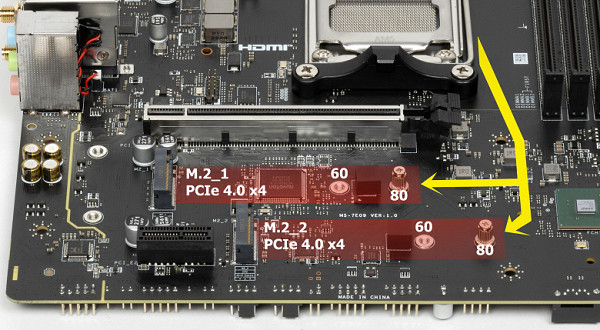
Both M.2 slots receive data from the processor.
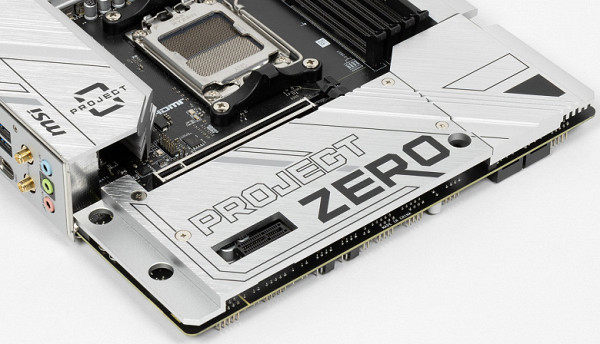
Both M.2 slots have a single common heatsink, which is screwed on one side to the chipset heatsink.
Peripheral functionality: USB ports, network interfaces, input/output
Next up are the USB ports. Let's start with the back panel, where most of them are located.
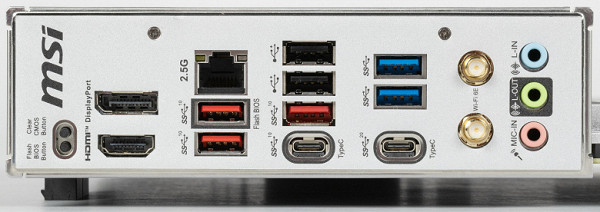
To recap: the B650 chipset can support up to 6 USB 3.2 Gen2/1 ports, 1 USB 3.2 Gen2x2 port, and 6 USB 2.0 ports. Ryzen 7000/8000/9000 processors provide up to 4 USB 3.2 Gen2 ports and 1 USB 2.0 port.
Also worth noting are the 12 PCIe lanes from the chipset, which are used to support storage devices, network controllers, and other controllers (7 of which have already been allocated).
As a result, there are 16 USB ports on the motherboard:
- 1 USB 3.2 Gen2x2 port: implemented via the B650 and presented as a Type-C port on the rear panel.
- 5 USB 3.2 Gen2 ports: 3 of which are implemented via the processor and are represented by two Type-A ports (red) and one Type-C port on the rear panel; 2 more ports are implemented via B650 and are represented by one Type-A port (red) and an internal Type-C port.
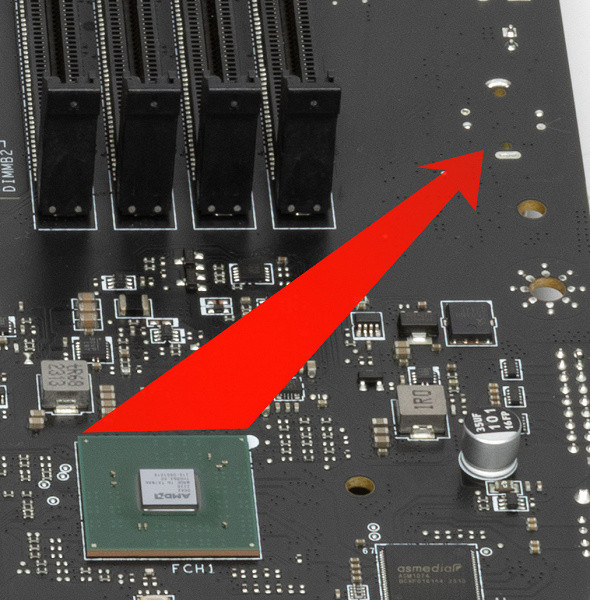
for connection to the corresponding connector on the front panel of the case;
- 4 USB 3.2 Gen1 ports: two implemented via the ASMedia ASM1074 controller
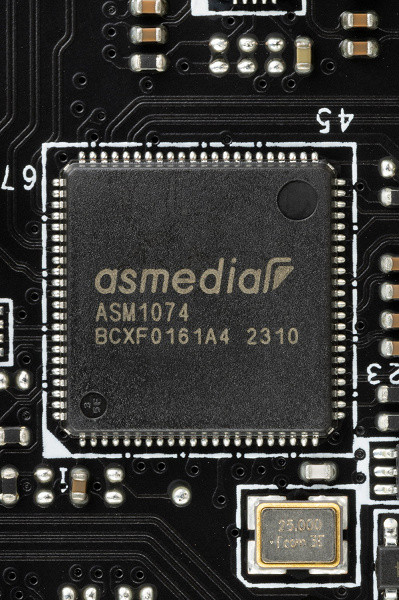
(1 USB 3.2 Gen1 line from the CPU is spent on it) and is represented by an internal connector on the motherboard with 2 ports;
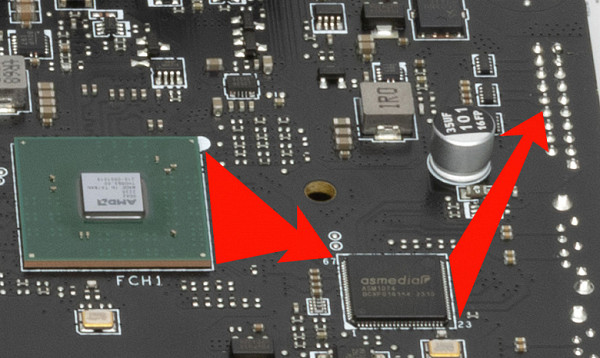
the other two are implemented via the second ASMedia ASM1074 controller (it uses 1 USB 3.2 Gen1 line from B650)
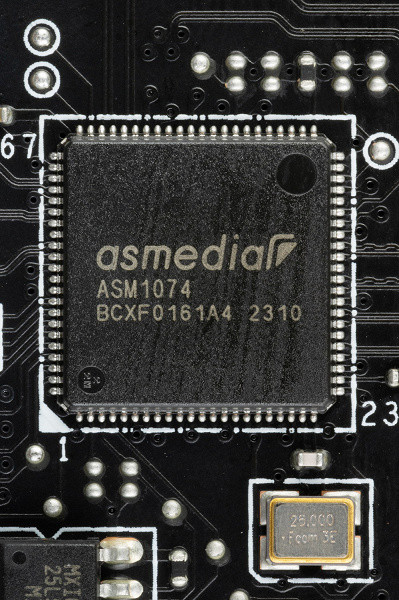
and are represented on the rear panel by two Type-A ports (blue);
- 6 USB 2.0/1.1 ports: 4 implemented via the Genesys Logic GL850G controller
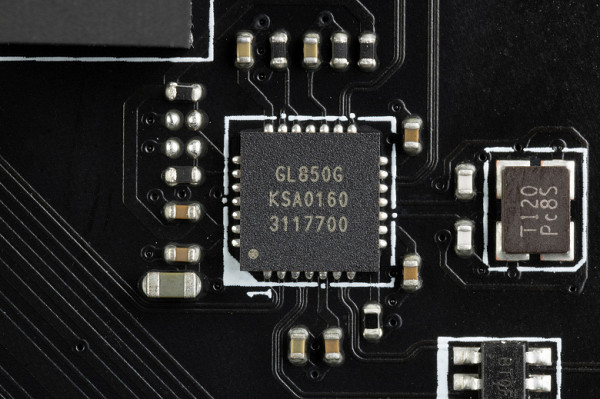
(1 USB 2.0 line from the CPU is spent on it) and is represented by two internal connectors (each with 2 ports);
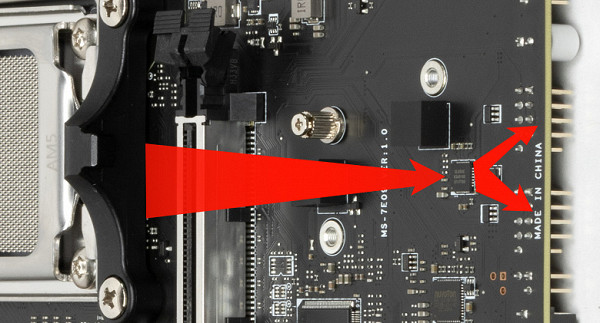
2 more are implemented via the B650 and are represented by 2 Type-A ports on the rear panel (black).
Thus, the B650 chipset provides 1 USB 3.2 Gen2x2 port, 1 USB 3.2 Gen2 port, 1 USB 3.2 Gen1 port, and 3 USB 2.0 ports (let's not forget that the wireless controller requires one USB 2.0 line).
In addition, 7 PCIe lines are allocated to support other peripherals. As a result, the B650 in this case provides 10 high-speed ports.
All USB Type-A and Type-C ports are equipped with signal amplifiers from Diodes Inc. (formerly Pericom).
For fast charging, the Type-C ports on the rear panel and a similar internal port for connecting to the front panel have redrivers from the same company.
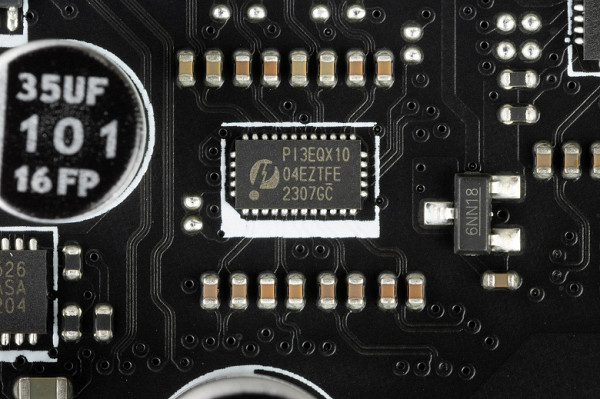
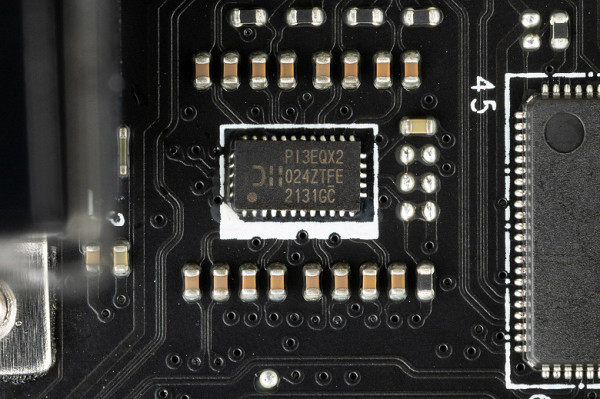
Now let's move on to networking capabilities.
The motherboard offers good communication capabilities. It has a Realtek RTL8125BG Ethernet controller, which provides speeds of up to 2.5 Gbps.
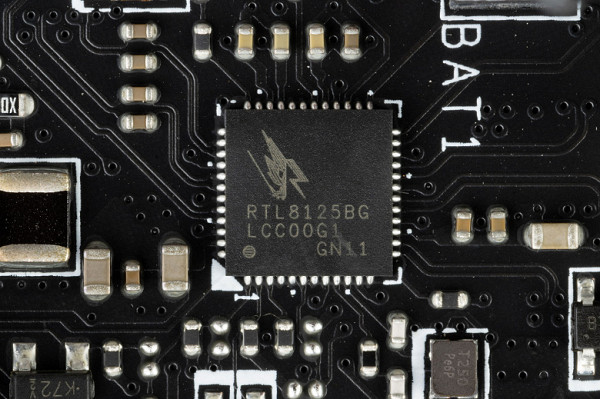
There is also a wireless adapter on the MediaTek MT7921 controller (AMD RZ608), which supports Wi-Fi 6E (802.11a/b/g/n/ac/ax) and Bluetooth 5.3. The adapter is installed in the M.2 slot (E-key), and the connectors for connecting external antennas are located on the rear panel.
The plug, traditionally placed on the rear panel, is already placed in this case and is shielded from the inside to reduce electromagnetic interference.
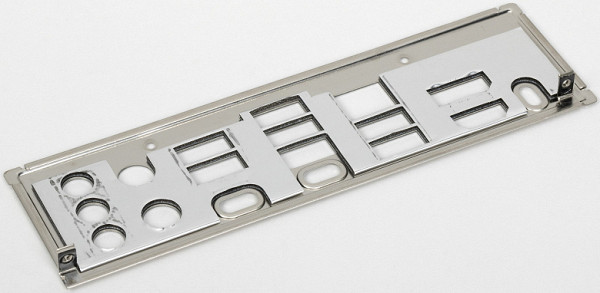
Audio subsystem
This board is equipped with a very old Realtek ALC897 audio codec. It provides sound output for up to 7.1 circuits.
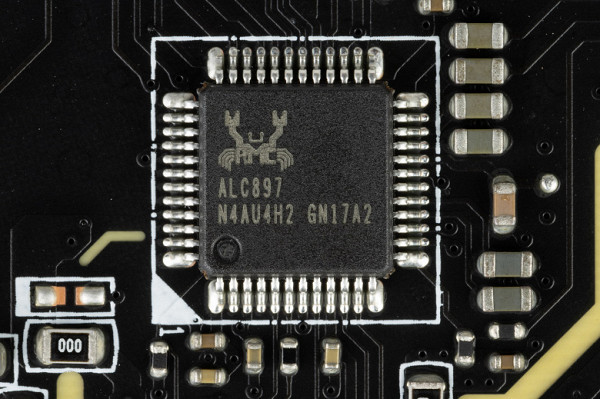
The board's audio circuits use «audiophile» capacitors.
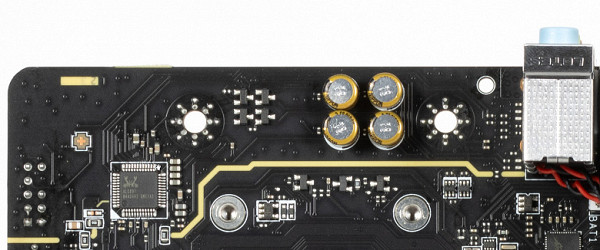
The audio path is located in the corner of the motherboard and does not intersect with other components. On the back panel of the card there are three connectors with standard color coding for receiving and outputting audio signals. There is no S/PDIF connector.
To connect a 7.1-channel system, you need to use the jack on the front panel of the case, which requires connecting the internal audio connector of the motherboard to the front panel.
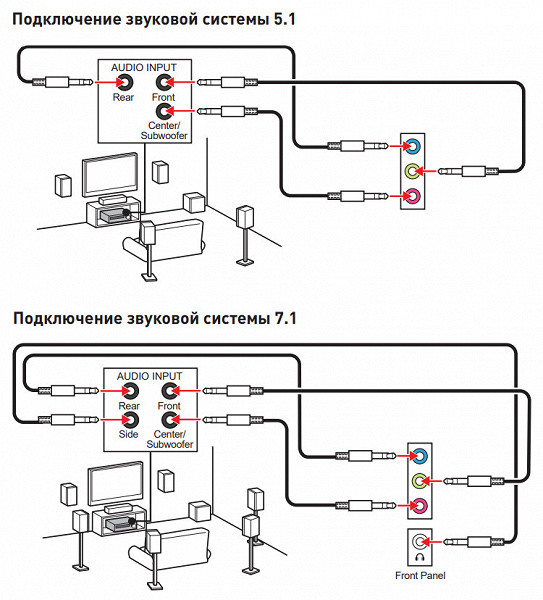
Power, cooling
There are 3 connectors for powering the board: in addition to the 24-pin ATX, there are two more ATX12V (8 contacts). All of them are located on the back side of the motherboard.
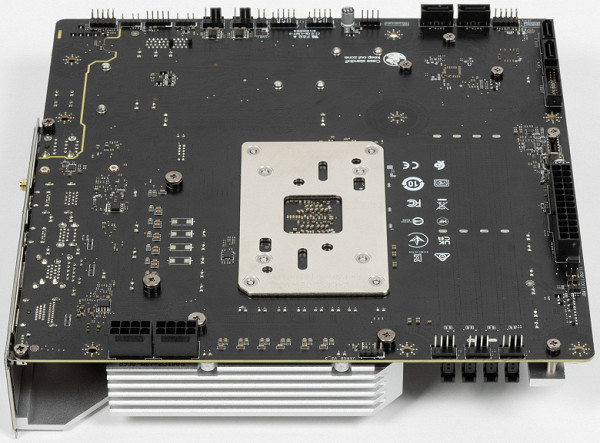
For a motherboard with a mid-budget chipset, the power supply system looks good.
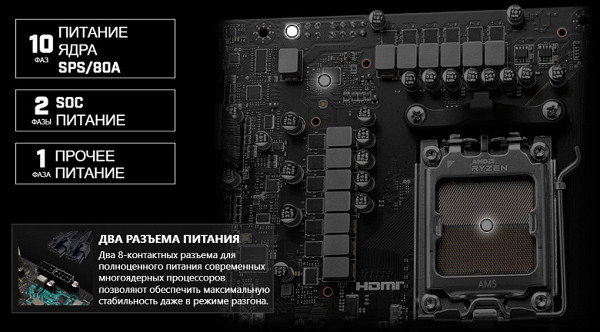
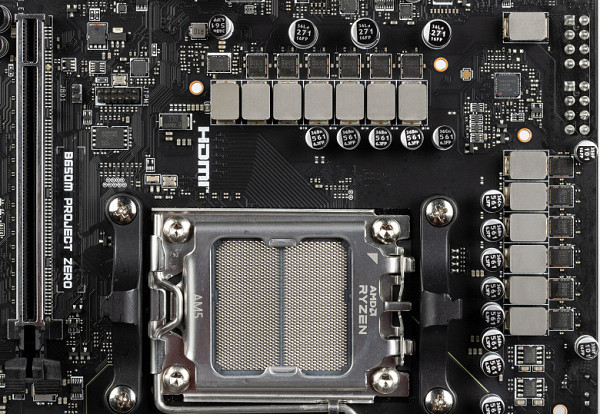
The motherboard power supply scheme has a 10+2+1 appearance: 10 phases for the processor core, 2 phases for the SoC (Ryzen I/O chiplet) and 1 phase for VDD_MISC (integrated graphics).
All phases are controlled by the MP2857 digital controller from Monolithic Power Systems, which is capable of controlling a maximum of 9 phases. As a result, the VCore power supply phases operate in parallel: 5x2+2+1, which actually corresponds to 8 phases.
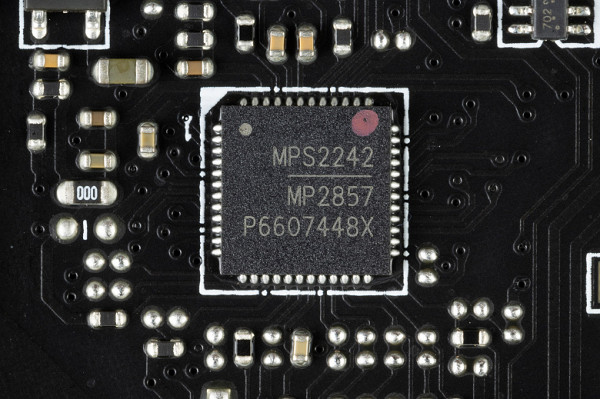
Each phase of the VCore and SoC has a transistor assembly MP87670 from MPS (up to 70A).
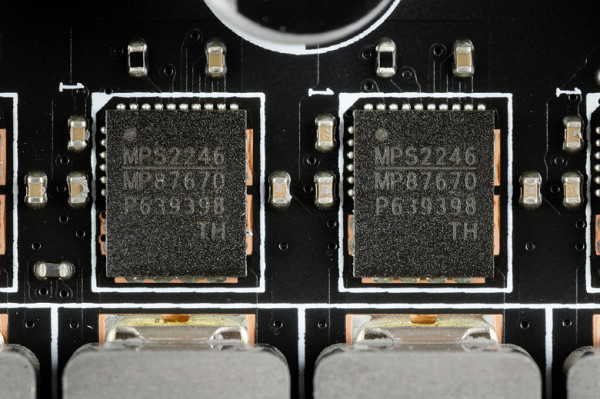
The phase for the integrated graphics has its own transistor assembly MXL7630S from MaxLinear (up to 30A).
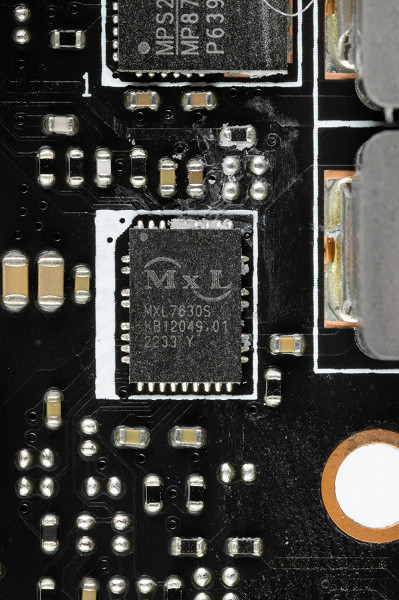
Now about the cooling system.
All potentially hot elements are equipped with individual heatsinks. The B650 chipset is equipped with a heatsink with a fairly large area, which effectively copes with cooling without the need for a fan. In addition, a common heatsink for the M.2 slots is attached to it.
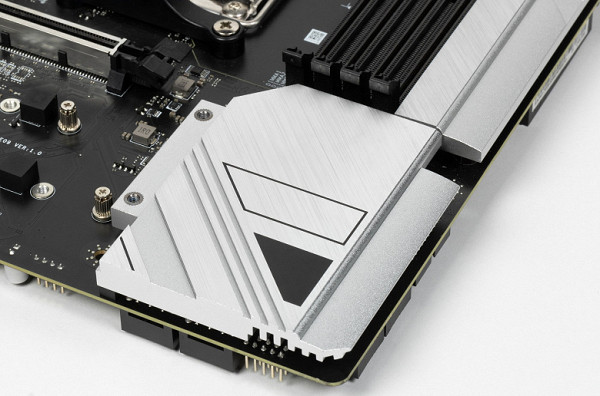
The rest of the cooling elements are quite ordinary and familiar.
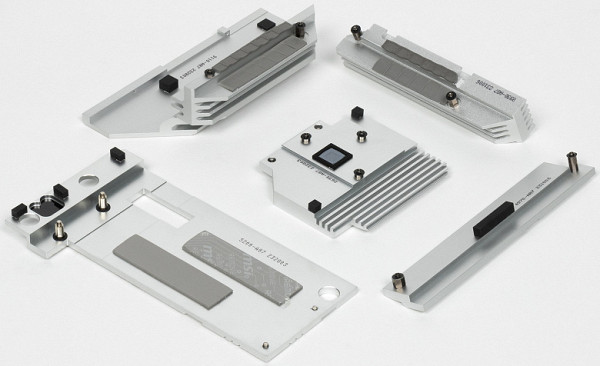
Two groups of power converters are equipped with separate radiators. The side metal bar with a black plastic stop in the center plays an exclusively design role and hides the soldering points of the main 24-pin power connector of the motherboard.
Both M.2 modules, as mentioned earlier, have a common radiator with a thermal interface.
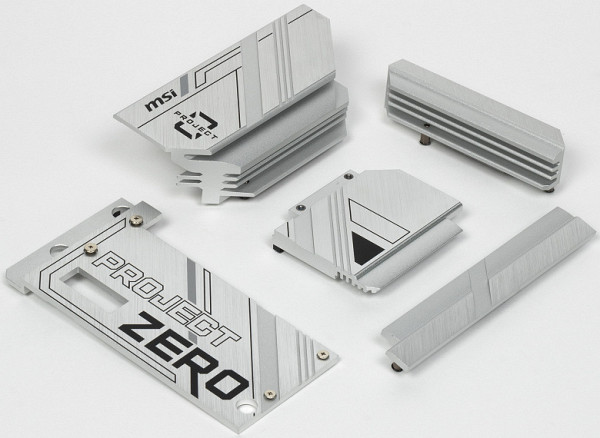
Backlight
The motherboard does not have built-in lighting, but it is equipped with three connectors for connecting external ARGB lighting, which can be controlled through the MSI Center program.
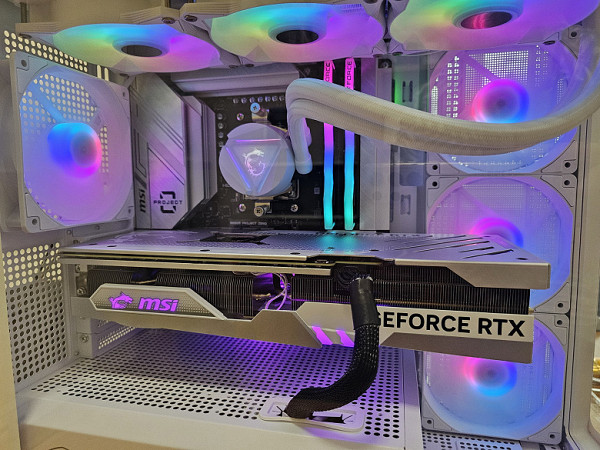
If you don’t like the backlight, you can always turn it off via software (it’s controlled using the Mystic Light utility, which is already built into MSI Center).
Software for Windows
All software can be downloaded from the manufacturer's website MSI.com.
Management is performed using the universal MSI Center program.
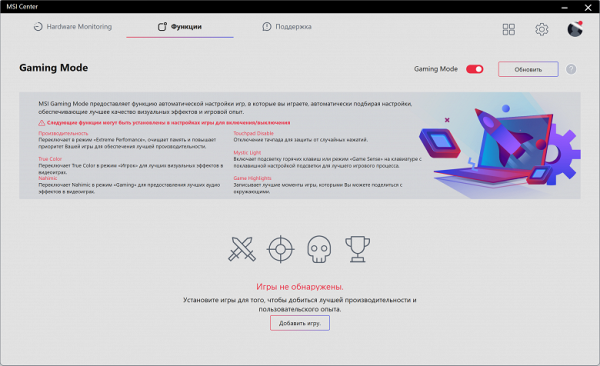
There is an analogue of the GeForce Experience program from Nvidia, as well as settings in AMD drivers that automatically select the optimal parameters for games depending on the PC configuration. The decision whether to trust this AI is up to the user.
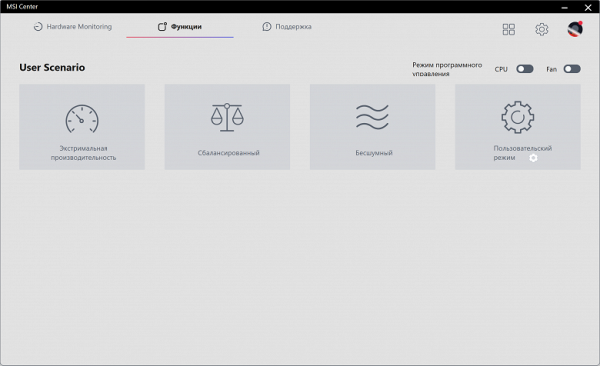
The motherboard operation can be configured not only by frequencies and voltage, but also by adjusting the operation of the fans. Particular attention should be paid to the new software function — control of all fans using AI. In this case, the CPU and GPU temperatures are taken as reference points, including data from Nvidia, AMD and Intel video cards, as well as readings from the built-in sensor on the motherboard, located next to the video card.
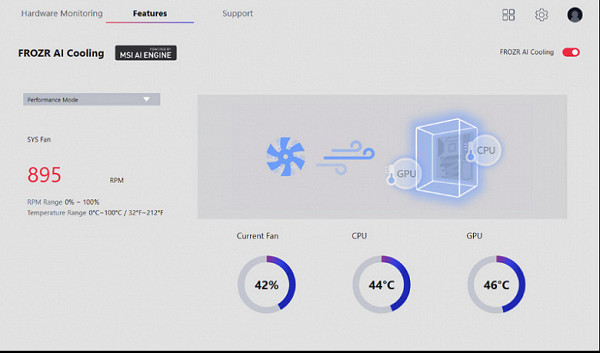
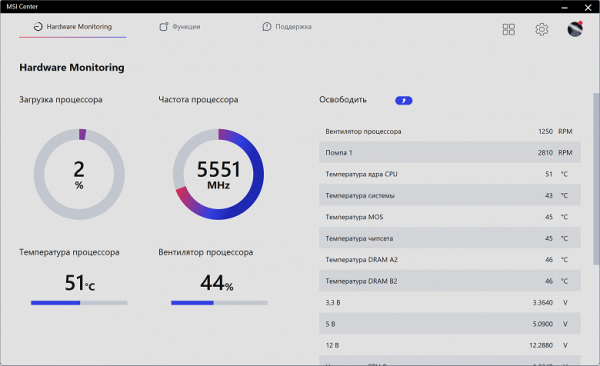
Status monitoring is a mandatory tab for all modern utilities.
BIOS settings
All modern motherboards are equipped with UEFI (Unified Extensible Firmware Interface), which are essentially mini-operating systems. To access the settings when booting the PC, you usually need to press the Del or F2 key.
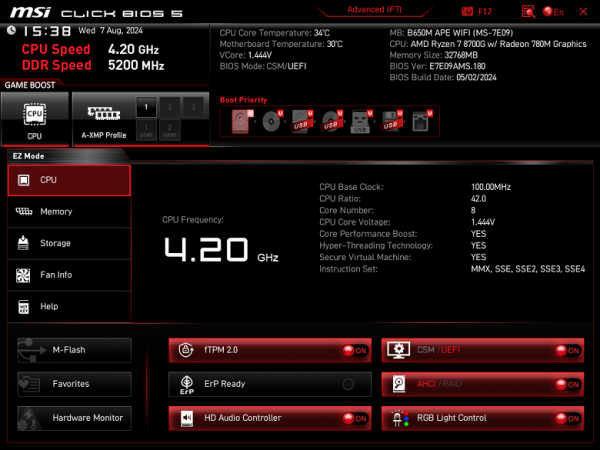
We get into the general “simple” menu, where there is a lot of information, but little can be changed, so we press F7 and get into the “advanced” menu.
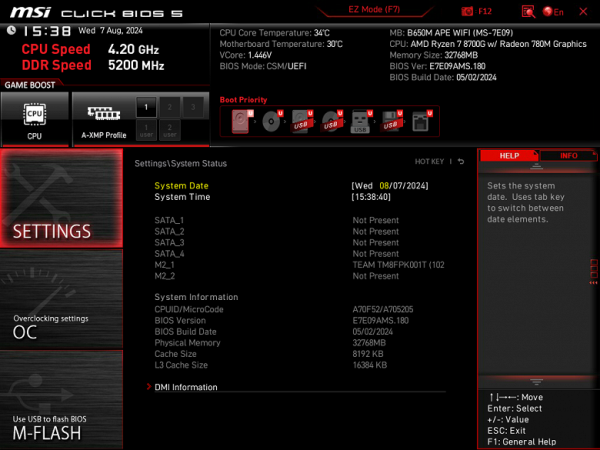
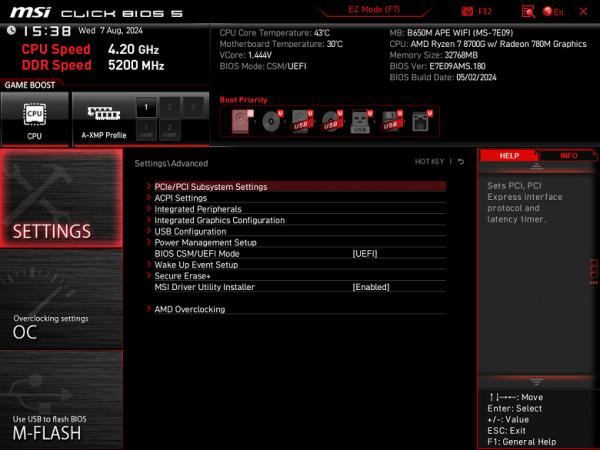
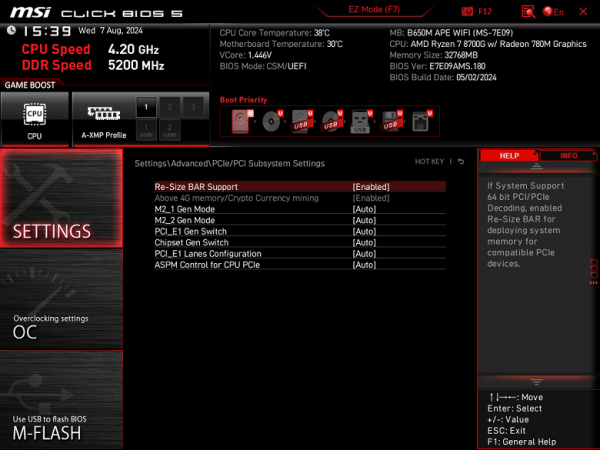
Peripheral management, you can control each USB port, change the operating modes of PCIe and M.2 slots.
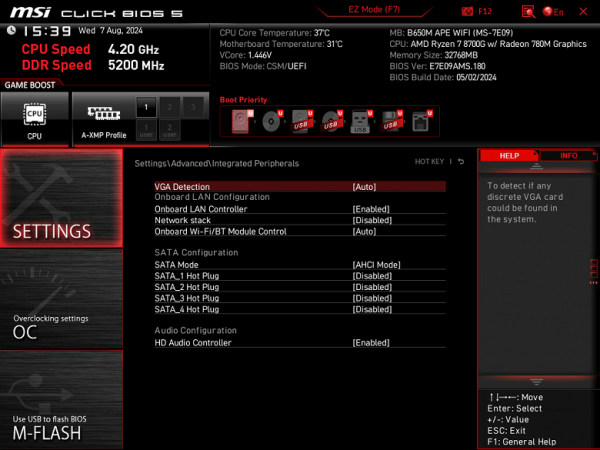
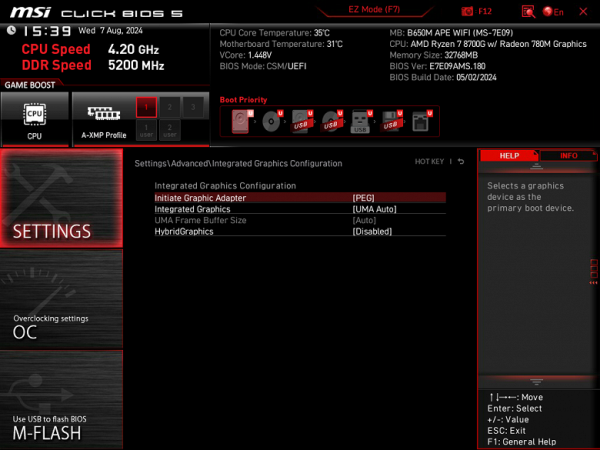
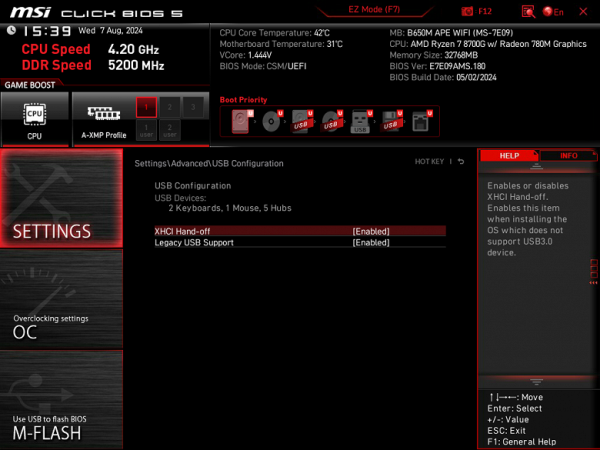
Monitoring and boot menu options are well known to everyone. There is also a utility for configuring the fan sockets.
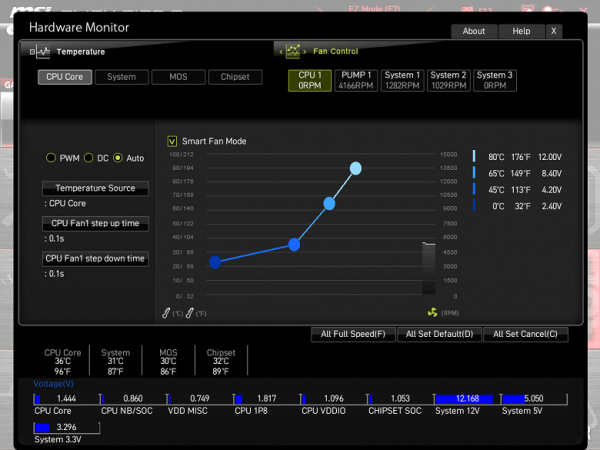
For overclocking, there are essentially already standard options within the framework of what Ryzen processors and RAM support
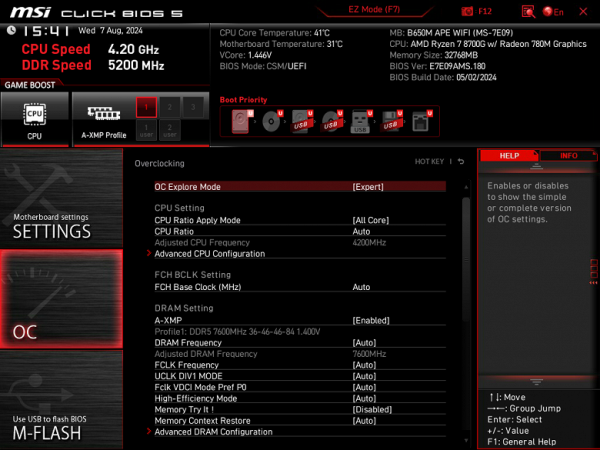
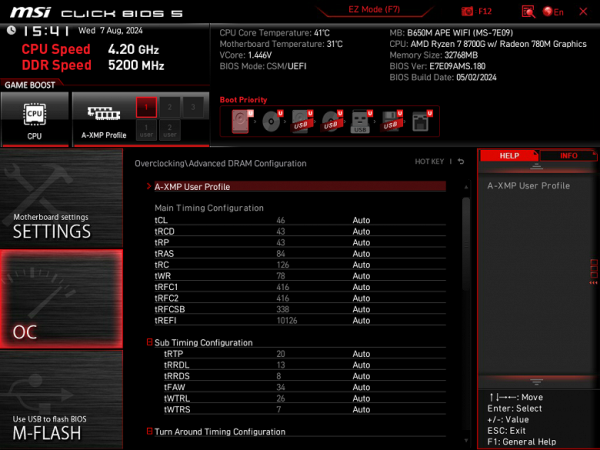
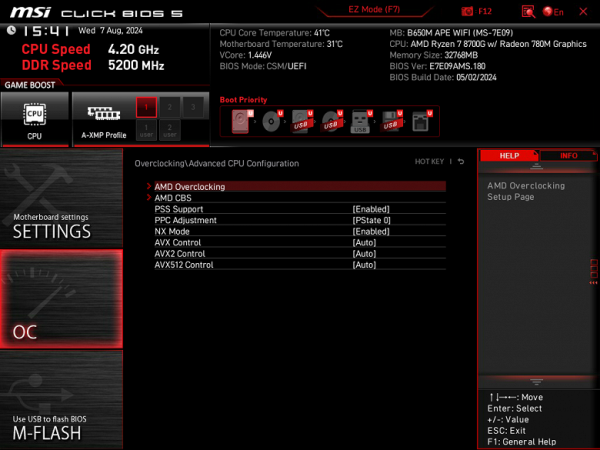
There are quite a few options, but for modern high-performance processors, many of them may not be so relevant, since the processor already operates at significantly increased frequencies. If your RAM supports XMP or EXPO profiles, do not forget to activate them in the BIOS. There is also a built-in AI-based function for optimizing memory settings and improving performance.
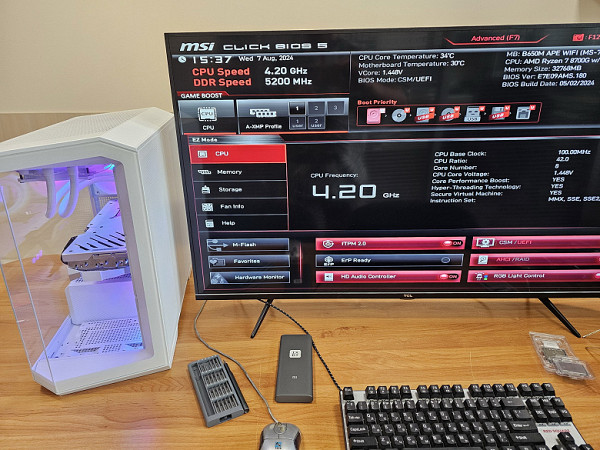
Performance (and overclocking)
Full configuration of the test system :
- MSI B650M Project Zero motherboard;
- AMD Ryzen 7 8700G 4.2 — 5.1 GHz processor;
- TeamGroup T-Force Delta RGB RAM 32 GB (2×16) DDR5 (CL36-46-46-84) (XMP 7600 MHz);
- TeamGroup MP44L NVMe PCIe 4.0 1TB SSD drive;
- video card MSI GeForce RTX 4070 Gaming X Slim White;
- Power supply Super Flower Leadex Platinum 2000W (2000 W);
- СЖО MSI MAG Goreliquid 360R V2 White;
- TV LG 55Nano956 (55″ 8K HDR);
- USB — keyboard and mouse.
Software:
- Operating system Windows 11 Pro, 64-bit
- AIDA 64 Extreme
- 3DMark Time Spy CPU benchmark
- 3DMark Fire Strike Physics benchmark
- 3DMark Night Raid CPU benchmark
- HWInfo64
- OCCT v.13.1.4
- Adobe Premiere CS 2019
We launch everything in default mode. Then we load it with tests from OCCT.
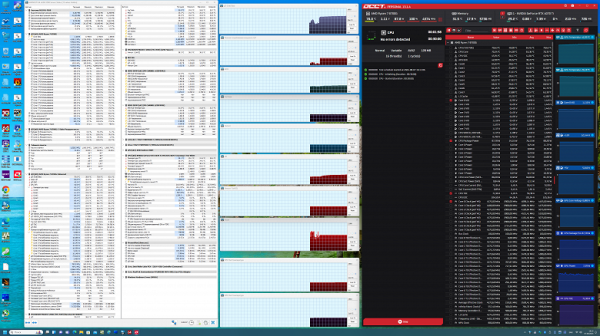
We see that the auto overclocking worked, reaching 4.4 GHz. It should be noted that during all tests there were no problems with the operation of related components, overheating or other strange phenomena. Considering that a mid-range processor was used to test this board, clearly not intended for overclocking, we were not surprised by such a modest auto overclocking. In addition, due to time constraints, we did not have the opportunity to study in detail the settings for increasing the efficiency of auto overclocking.
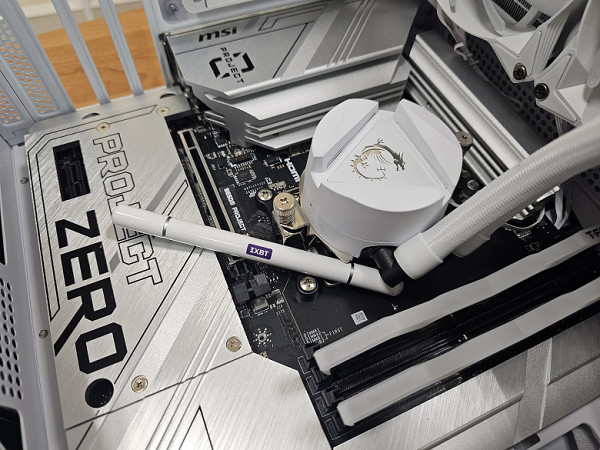
Conclusions on the motherboard
MSI B650M Project Zero is the second representative of the new motherboard design in our lab after Gigabyte B650E Aorus Stealth Ice. The uniqueness of these models is that most of the connectors are located on the back side of the PCB, while the slots for RAM, expansion cards and the processor socket remain in their usual places. This approach makes it easier to replace components, since all the «extra» wires are hidden behind the base of the motherboard, which is especially important for cases with transparent walls. However, this will require a special case that provides access to all the remote connectors.
Despite this unique feature, the board is standard — microATX format, mid-range, with an AMD B650 chipset and a price of 30 thousand rubles. It offers 16 USB ports of various types, including one of the fastest USB 3.2 Gen2×2, one PCIe x16 slot receiving 16 PCIe 4.0 lanes from the processor, and one PCIe x1 slot, as well as two M.2 slots connected directly to the processor using PCIe 4.0 lanes. This model also has four SATA ports and five fan headers. Although the board belongs to the mid-price segment, the processor power system looks quite decent. Network capabilities include a wired 2.5 Gbps controller and a wireless adapter with support for Wi-Fi 6E and Bluetooth 5.3. Among the advantages, we can note the wide range of options for connecting additional ARGB devices (there is no support for non-addressable RGB lighting).
In addition, the MSI B650M Project Zero offers a standard set of settings in the BIOS for overclocking enthusiasts.
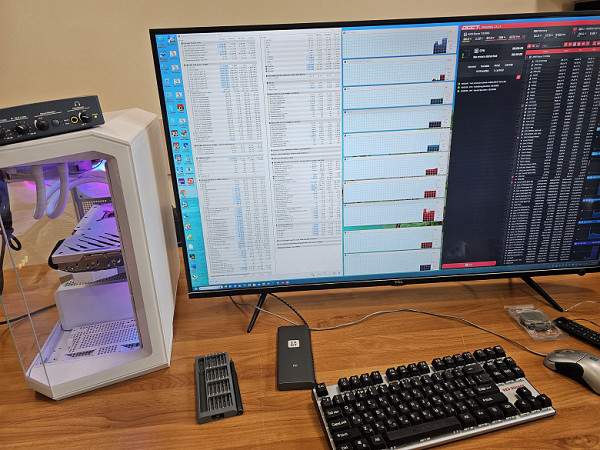
The Need for Back-Connect Enclosures
As mentioned earlier, installation of motherboards with «reverse» placement of connectors requires special cases equipped with corresponding cutouts in the carrier panel. For testing, we used the MSI MAG Pano M100R PZ/White case. On the company's website, you can find a list of cases from various manufacturers that are compatible with Back-Connect motherboards.
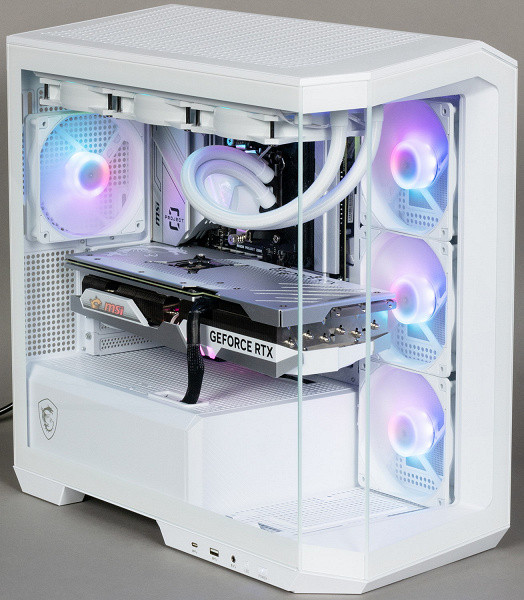
Agree, it is quite unusual to see a PC in which only one cable for powering the video card remains visible. In addition, the lower casing of the case has a special cutout to hide this cable as much as possible.
